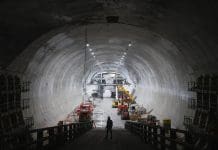As geospatial information becomes critical for modern construction projects, who is measuring the measurement?
In 2020, it was recognised the huge value that location data and geospatial insights could offer the UK economy in the Geospatial Commission’s paper Enhancing the UK’s Geospatial Ecosystem.
In the same year, the UK’s geospatial strategy to 2025 was launched. Since 2020, more than 30 new geospatial companies have been registered and are still operational, according to Companies House.
With the sector continuing to grow, and its capabilities becoming increasingly apparent due to the huge amounts of data that is held on our changing built environment and landscapes, it begs the question: for a sector so concerned with accuracy and verification, who is responsible for measuring the measurement?
For construction professionals, who want to ensure the value and expertise of their growing supply chain, it’s important that this is defined so that quality can be guaranteed, regardless of the volume of data being collected.
The role and responsibility of the surveyor and the geospatial information that is gathered are continuously evolving. There are increasing options for cutting-edge technologies and advanced measurement methods that complement the experience of a qualified geospatialist.
While these enhanced capabilities have opened new possibilities, they have also introduced greater complexity to the responsibilities of geospatial professionals. New tools, processes and software have unlocked an entire industry of knowledge that is yet to be fully explored.
Despite this, officially recognised industry standards for geospatialists are struggling to keep pace with advancements in technology and data. Geospatial data is a foundational element of construction projects and having inaccurate data can significantly impact a project’s outcome.
Bad data, bad decisions
Bad data, defined as inaccurate, incomplete, inaccessible, inconsistent or untimely information, poses significant challenges in construction projects.
According to Autodesk, in the UK, 32% of construction data leads to poor decisions 31% of the time. In Ireland, this situation is even worse, with 41% of data resulting in poor decisions 46% of the time.
In today’s global construction landscape, where projects involve various sites and stakeholders, critical decisions are made quickly and concurrently. Poor data can create misunderstandings about a project’s status, potentially leading to mistakes that impact numerous individuals.
Many of us can relate to the overwhelming feeling of dealing with an overflowing email inbox or multiple versions of the same photo on our phones. Deciphering relevant information from this clutter can be time-consuming and tedious.
This is the same as having data from various sources or missing data on construction sites. Trusting bad data is a risk that is not worth taking.
Why standards matter
As the industry continues to grow and the geospatial reality becomes established, it will be crucial to have an authoritative set of regulations that inform a project’s decision-making process. Precision is essential in the geospatial industry, just as it is in any other business. Standards ensure that the data is accurate and reliable, allowing professionals to have confidence in its quality.
You would be hesitant to eat food if it did not pass thorough and trusted checks before it was sold to the public. Like the food sector having quality marks to indicate safe consumption, geospatial data needs standards to ensure that it meets certain quality criteria. These standards would mitigate the bad data and restore confidence in a project’s outcome, while also reducing costs, lead times and mistakes.
Investing in accuracy will provide savings in the future
The cost of effort in geospatial management is a concept that, contrary to its name, often results in cost reduction and enhanced efficiency.
In traditional project deliveries, various stakeholders undertake geospatial activities with their own methods, leading to overlaps and a lack of information sharing.
Geospatial management aims to consolidate and standardise these activities by overseeing the handling of geospatial data and procedures. This standardisation streamlines processes, reducing the overall cost of geospatial activities.
However, the true value of geospatial management becomes evident when considering the indirect costs of errors and inaccuracies that can arise when geospatial tasks are not properly coordinated.
In essence, geospatial management is cost-neutral or even cost-positive when implemented, as it not only reduces expenses but also mitigates the potential financial repercussions of geospatial mishaps during and after construction projects.
By setting and enforcing standards and best practices, geospatial managers ensure the correctness and accuracy of measurements. This approach instils confidence among project stakeholders, assuring them that geospatial aspects are being handled correctly.
Geospatial management also plays a pivotal role in standardising measurement methods and protocols, ensuring consistency throughout the project’s lifecycle, from construction to the utilisation phase and beyond.
This standardisation not only enhances project efficiency but also facilitates the transfer of crucial information between different trade parties.
Geospatial management promotes a culture shift, emphasising the importance of proper measurement practices, similar to how safety protocols are enforced on construction sites.
It aims to ensure that everything is in the right place, with accurate supporting information, making it a vital component of modern project management and delivery.
Ultimately, the hope is that anyone, decades later, can return to ratified geospatial information and trust its validity and use that information as a springboard to make further use of an existing asset, prolonging the longevity of our built environment and its enhancing safety and sustainability.














